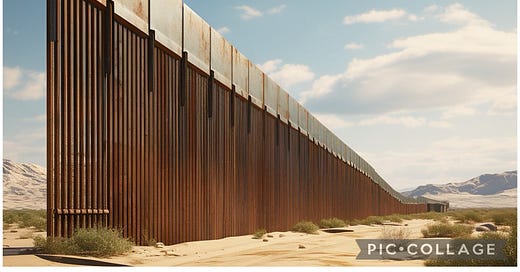This is the Mexico installment in Ad Astra’s American grand strategy for a multipolar world. The series contains 7 white papers: 2 global policies and 5 country-level strategies.
1. Introduction
2. Global trading alliance network
3. China
4. Russia
5. Middle East
6. Mexico
7. India
Sharing a 2,000-mile land border with the US, Mexico’s prospects are intertwined with and greatly important to America. Mexico is a top US trading partner, replacing China in in imports in 2023. The large reservoir of low-cost labor and close proximity makes Mexico an excellent economic partner to the US. But its limited state capacity and thriving drug cartels represent a grave geopolitical threat to the US. Unlike most forever wars, the war on the cartels is at home. A more detailed investigation of the cartel problem can be found in The North American Drug War. The US has two enduring national interests in Mexico: 1) partnering to build a North American manufacturing colossus and 2) partnering to degrade the ability of cartels to operate in the US-Mexico borderlands.
Figure 1: US-Mexico imports surpass US-China imports in 2023
Friendshoring
After China was admitted to the World Trade Organization in 2001, the US developed deep economic ties with China. The US would import vast quantities of cheap Chinese goods funded by trillions in US debt, sold to China. Some pundits called this interdependence “Chimerica”. The downsides for America are well documented and are summarized in American Deindustrialization. The trade relationship began to reverse itself in 2016 with the election of US President Donald Trump, who campaigned on and enacted anti-China trade policy. A trade war in 2019 followed by the COVID-19 pandemic in 2020 led to even greater reductions in US-China trade and talk of “decoupling”, or eliminating Chinese trade entirely. As a result, private firms began to move their supply chains and future investments out of China to countries deemed friendlier.
One of the primary beneficiaries of this trend, deemed “friendshoring”, was Mexico. Since the pandemic, fixed investment in Mexico (covering things like construction of new plants, investment in new equipment, etc.) has boomed to almost +30% per year. Mexico’s relatively low-cost labor supply makes it extremely attractive for labor-intense, unskilled manufacturing that could not survive in the US. The United States Mexico Canada trade agreement (USMCA) codifies this trade relationship. In the future, the US has the opportunity to pair low-cost Mexican labor with high value-add American labor to create a North American manufacturing juggernaut.
Figure 2: Fixed investment in Mexico
North American Drug War
The Mexican drug cartels are non-state actors operating in Mexico, the US-Mexico borderlands, and in the US. They pursue any activity that earns a profit, including in black markets outside of the law. They profit from drug smuggling, human trafficking, assassination-for-hire, and various other illegal activities, even smuggling avocados. They thrive because Mexico lacks the state capacity to enforce the rule of law and suffers from corruption at the local, state, and federal levels. In this way, their operation is not dissimilar to terrorist non-state organizations operating in failed states like Afghanistan, except cartels are driven by profit rather than ideology.
The threats from the unimpeded operation of these cartels includes, but are not limited to, violence, drug smuggling, deteriorating economic competitiveness, and US national security. First, escalating violence in Mexico has spread to the US-Mexico borderlands, threatening civilians, tourists, and investment. Second, the US drug addiction has given way to the much deadlier fentanyl epidemic, which kills over 100,000 Americans each year. Third, the cartels risk reversing the “friendshoring” trend in Mexico if investors deem the country too dangerous for investment. Finally, in an era of transnational terrorism and great power competition, a permissive border risks letting terrorists, spies, and other bad actors into America.
US-Mexico policy
The US should catalyze supply chain investments in Mexico by building out US-Mexico logistics infrastructure, including roads, rails, pipelines, and other cross-border projects. Special focus should be paid to highway border checkpoint congestion, which is costly to cross border trade. A bank specializing on US-Mexico infrastructure should be created.
Figure 3: Congestion at the US-Mexico border crossing
Combatting the Mexican cartels is essential but must be approached with great care, implementing the lessons from the Global War on Terror. Foremost, any initiatives against the cartels must be conducted jointly with Mexico. Military assets should be used against the cartels but civilian collateral damage is not acceptable. Drones should be used, but only for surveillance. Lethal drone strikes should be banned in Mexico. The US southern border should be hardened, emphasizing the deployment of new surveillance technology.
Based on German, Polish, and other European immigrant voting behavior in WW1 and WW2, Mexican-Americans will be a significant political bloc in 21st century American politics. Therefore, any sustainable policy against the Mexican cartels must not run afoul of this bloc’s interests.
The evolving dynamic between the US and Mexico goes beyond geographical proximity. Mexico's economic potential, in tandem with the challenges posed by drug cartels, presents the US with unique opportunities and threats. As "friendshoring" gains momentum, the potential for an enhanced economic partnership has never been greater. However, the threat from cartels necessitates cooperative, well-thought-out strategies, ensuring that both countries progress without impeding on the sentiments of their intertwined communities. As the US looks to the future, its policy towards Mexico should be characterized by mutual respect, shared objectives, and an unwavering commitment to security, prosperity, and the values that bind our nations together.
1. Introduction
2. Global trading alliance network
3. China
4. Russia
5. Middle East
6. Mexico
7. India







